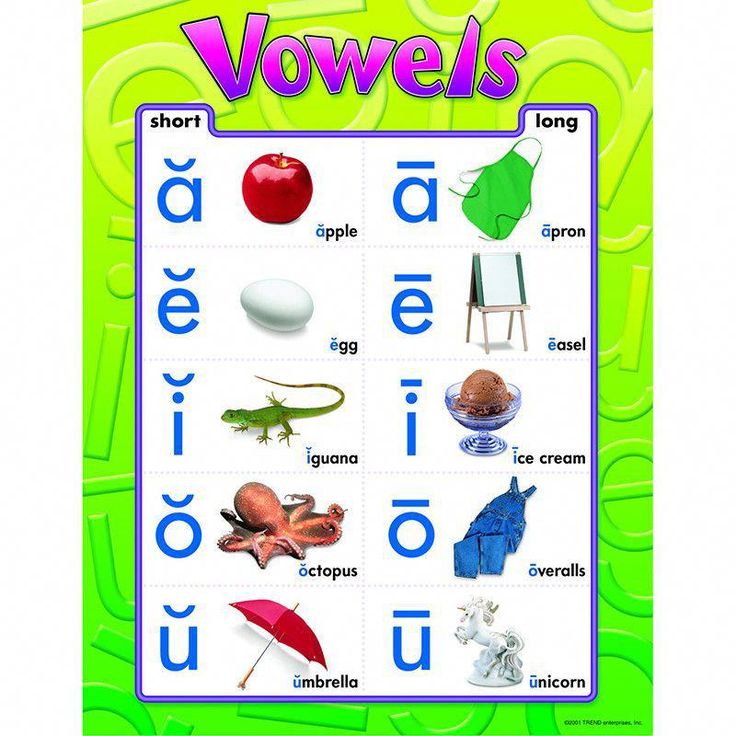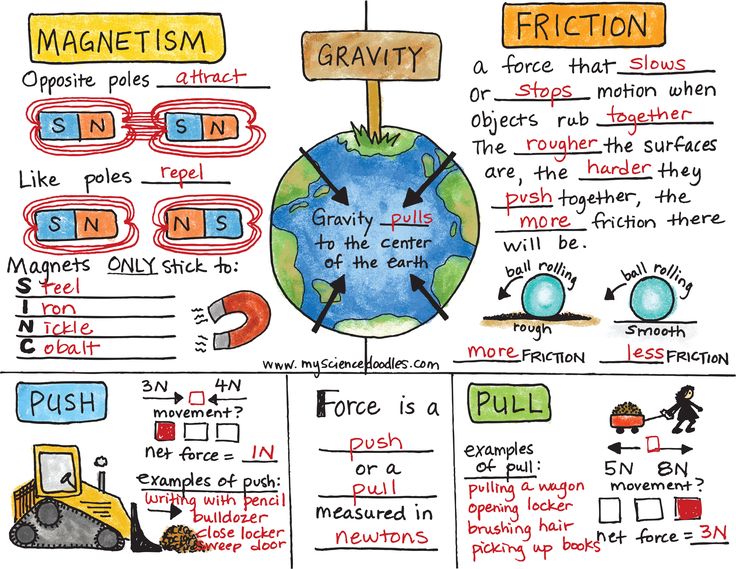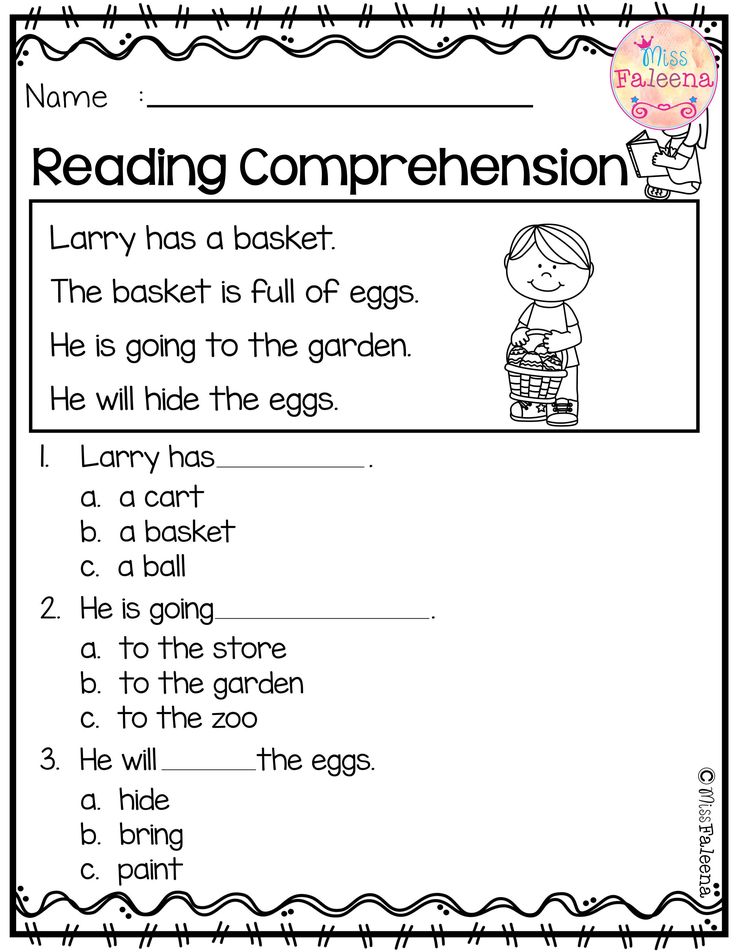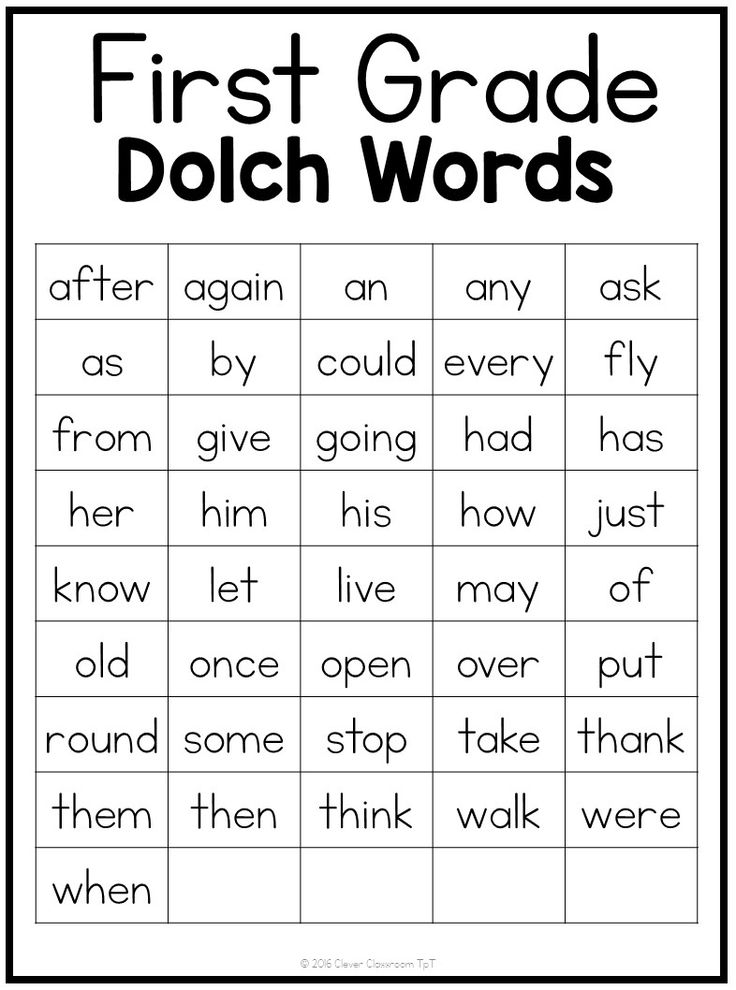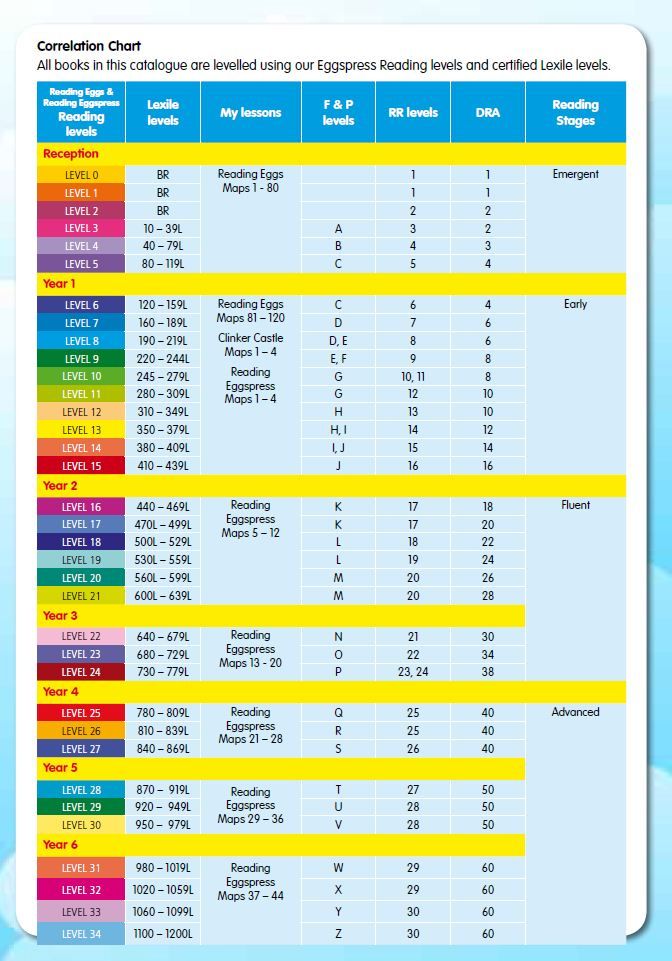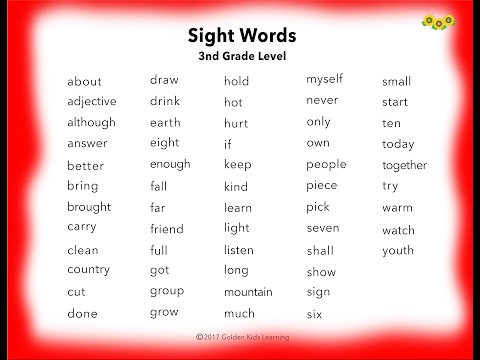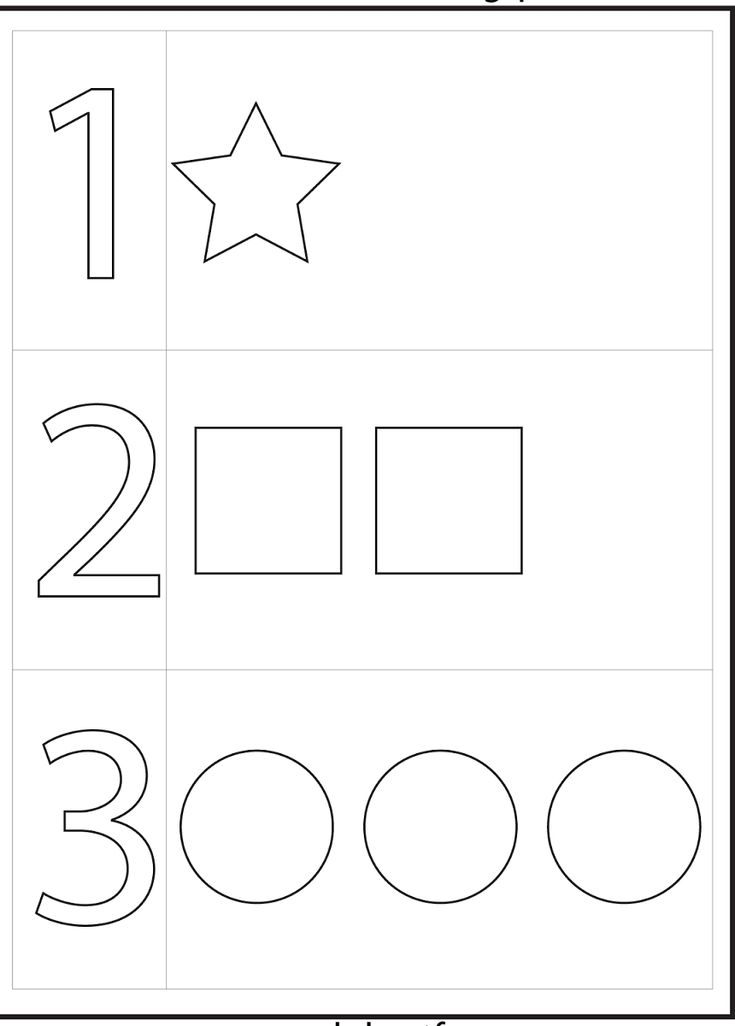Long and short vowels symbols
Short Vowels and Long Vowels Lesson Plan
Objectives:
- Students will learn how to recognize and remember the sounds of both short vowels and long vowels.
- Students will be able to produce the sounds of the short vowels and long vowels in isolation.
About the Concept:
Vowels in the English language can represent a variety of sounds. The first step in mastering the various vowel sounds is learning the difference between short vowels and long vowels. Of the two, the long vowels are easier for children to learn because long vowels basically sound the same as the letter names. For example, long a sounds like the a in able, long
o sounds like the o in over, and long u may sound like the u in use or the u in blue. Children generally find it more challenging to learn the short vowel sounds because many of them sound so similar to each other: The short i in pig sounds very similar to the short e in peg. The short o in pop sounds a lot like the short u in pup. Before children can learn the rules for spelling and reading short and long vowel sounds, they must be able to recognize and produce these sounds reliably. The short vowels can represented by a curved symbol above the vowel: ă, ĕ, ĭ, ŏ, ŭ. The long vowels can be represented by a horizontal line above the vowel: ā, ē, ī, ō, ū. Here are some examples of short vowel words: at, egg, it, ox, up.
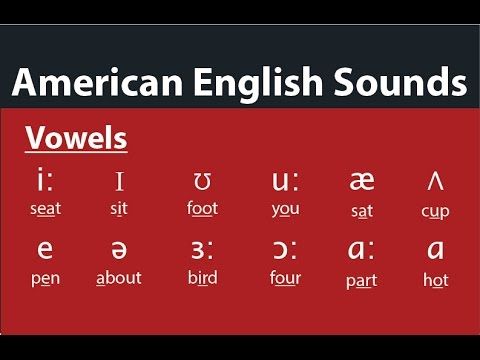 Here are some examples of long vowel words: ate, each, ice, oak, use. When students have learned to recognize the vowel sounds in
Oh, Do You Know?, they can learn short vowel spelling patterns through the Volume 1 song Spelling Families. Long vowel spelling patterns are covered in the Volume 1 songs Talking and Walking and Silent E. Some other songs that teach students about vowel spelling patterns are the Volume 2 songs, Spelling Choices, Cool Vowels, The Right Diphthong, and I Before E, and the Volume 3 songs Why Does Y? and Drop It!.
Here are some examples of long vowel words: ate, each, ice, oak, use. When students have learned to recognize the vowel sounds in
Oh, Do You Know?, they can learn short vowel spelling patterns through the Volume 1 song Spelling Families. Long vowel spelling patterns are covered in the Volume 1 songs Talking and Walking and Silent E. Some other songs that teach students about vowel spelling patterns are the Volume 2 songs, Spelling Choices, Cool Vowels, The Right Diphthong, and I Before E, and the Volume 3 songs Why Does Y? and Drop It!.
Materials:
- Sing Your Way Through Phonics Volume 1 CD, Tracks 9 and 10 (Listen to audio sample)
- Sing Your Way Through Phonics Volume 1 Mini-Charts (pp. 41-46)
- Letter cards for a, e, i, o, and u.
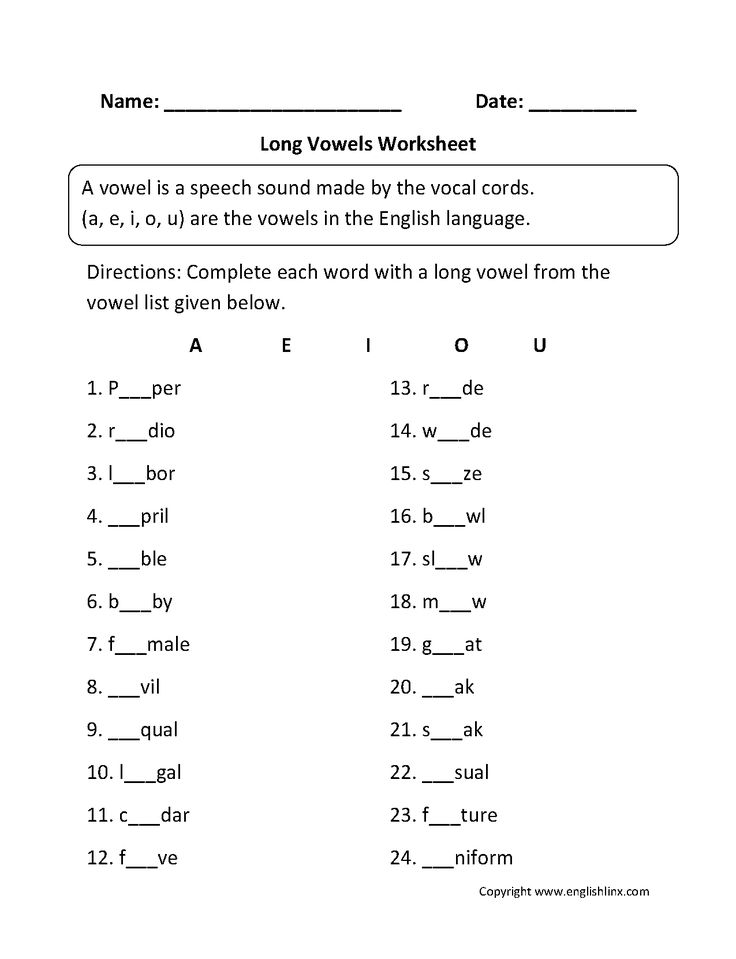
- Chart displaying long vowel words and pictures (ex. ape, eagle, ice cream, ocean, unicorn)
- Chart displaying short vowel symbols, words and pictures (ex. alligator, eggs, iguana, octopus, umbrella)
- Optional: Cards with medial-position short vowel pictures (ex. hat, cat, hen, pen, fish, dish, dog, log, gum, drum)
- Optional: Cards with medial-position long vowel pictures (ex. snake, rake, sheep, sleep, kite, night, goat, coat, flute, suit)
Note: If you do not have the CD or Mini-Charts, you can still teach this short vowels and long vowels lesson plan using the folk tune listed on the Oh, Do You Know? Song Lyrics page. You can create your own mini-charts using the words in bold print letters in each verse of the Song Lyrics.
Find out more about Sing Your Way Through Phonics products.
Order our cost-saving Volume 1 Combo online.
Procedure:
- Review the letter names of the vowels: a,
e, i, o, u, and sometimes y.
 Say, "Today, we are going to learn about how vowels can sound in words. We will focus on a, e, i, o, and u."
Say, "Today, we are going to learn about how vowels can sound in words. We will focus on a, e, i, o, and u." - Display letter cards a, e, i, o, and u. Say, "Sometimes it is easy to hear the vowel in a word. Can you tell me what vowel you hear in the word use (u), in the word eat (e), in the word ape (a), in the word ice (i), in the word oak (o)?" Point to the correct letter card, each time the children answer correctly. Say, "It is easy to hear the vowels in these words because they actually say their own names. When vowels sound just like their own letter names, we call these long vowels."
- Display the chart of the long vowels with pictures and symbols.
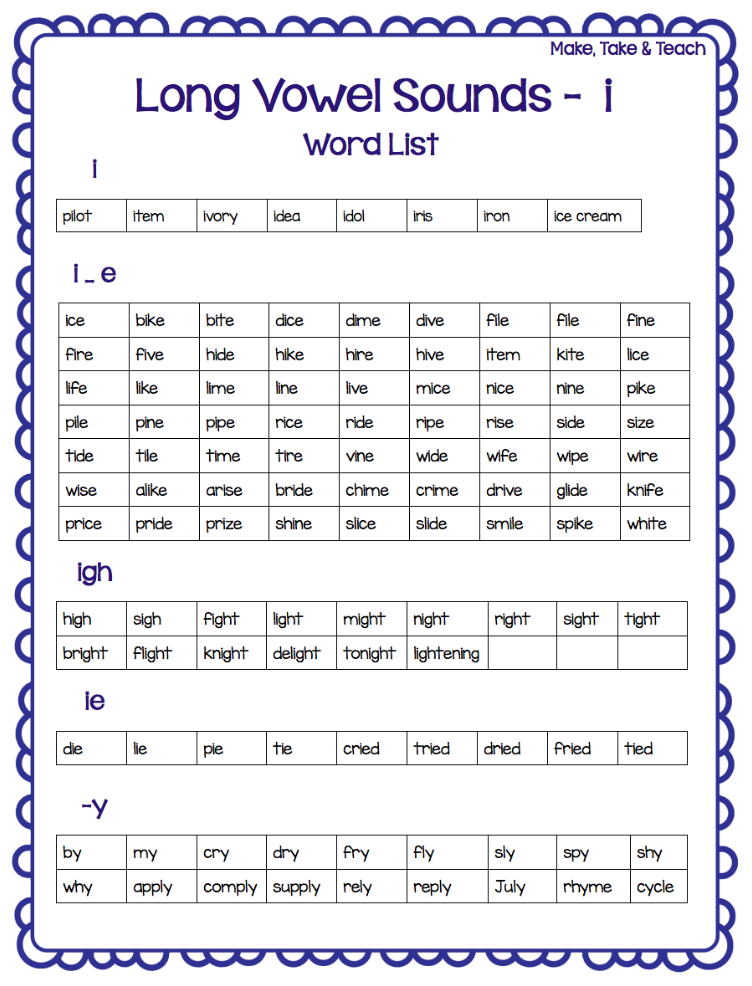 Point to the long vowel chart and say, "We can draw a long line over the vowel if we want to show that it has a long sound. Ask the students to draw this symbol in the air. " Point to
ā, and say, "Long a sounds like the beginning of ape." Say together, "Long ē sounds like the beginning of eagle. Long ī sounds like the beginning of ice cream. Long ō sounds like the beginning of ocean. Long ū sounds like the beginning of unicorn."
Point to the long vowel chart and say, "We can draw a long line over the vowel if we want to show that it has a long sound. Ask the students to draw this symbol in the air. " Point to
ā, and say, "Long a sounds like the beginning of ape." Say together, "Long ē sounds like the beginning of eagle. Long ī sounds like the beginning of ice cream. Long ō sounds like the beginning of ocean. Long ū sounds like the beginning of unicorn." - Say, "Sometimes a vowel has a different sound and does not say its own name." Show the chart with the short vowel words and pictures. Say, "This chart shows words that have a short vowel sounds."
- Point to the symbols on the short vowel chart and say, "We can draw a short smile over the vowel to show that it has a short sound.
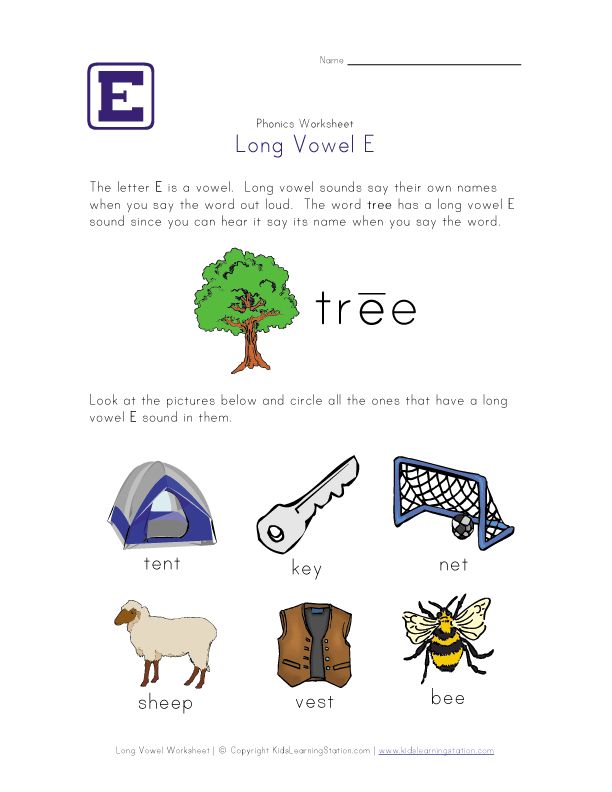 " Ask the students to draw this symbol in the air. Say, "Let's practice the short vowel sounds saying just the beginning of each word on the chart. Can you say just the beginning of the word alligator? (/ă/), the beginning of the word eggs? (/ĕ/), the beginning of the word iguana? (/ĭ/), the beginning of the word octopus? (/ŏ/), the beginning of the word umbrella?" (/ŭ/)
" Ask the students to draw this symbol in the air. Say, "Let's practice the short vowel sounds saying just the beginning of each word on the chart. Can you say just the beginning of the word alligator? (/ă/), the beginning of the word eggs? (/ĕ/), the beginning of the word iguana? (/ĭ/), the beginning of the word octopus? (/ŏ/), the beginning of the word umbrella?" (/ŭ/) - Say, “Now we are going to listen to a song about the vowel sounds to help us remember them. At first, the singers will sing about all the short vowel sounds. Next, the singers will sing about all the long vowel sounds. See if you can think the sounds for each vowel before you hear it in the song.” Play Sing Your Way Through Phonics Volume 1 CD, Track 9--Oh, Do You Know? and point to the Mini-Charts on pages 42-46.
- Point to the symbols on the chart and say, "Did you notice that the short smile and the long line can be written over either capital or lowercase letters? Let's listen to this song again and see if you can answer the singer's questions.
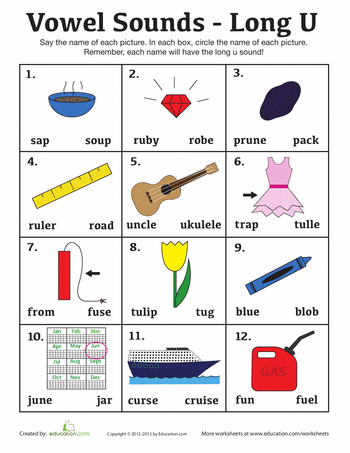 Re-play Sing Your Way Through Phonics Volume 1 CD, Track 9--Oh, Do You Know? Students will hear the question, "Oh, do you know the short a sound, the short a sound, the short a sound?" They should sing the answer, "Oh, yes I know the short a sound. The short a sound is /ă/." For the rest of the questions in the song, students should sing the aswers, "The short e sound is /ĕ/...The short i sound is /ĭ/...The short o sound is /ŏ/..., The short u sound is /ŭ/..., The long a sound is /ā/..., The long e sound is /ē/..., The long i sound is /ī/..., The long o sound is /ō/..., The long u sound is /ū/.
Re-play Sing Your Way Through Phonics Volume 1 CD, Track 9--Oh, Do You Know? Students will hear the question, "Oh, do you know the short a sound, the short a sound, the short a sound?" They should sing the answer, "Oh, yes I know the short a sound. The short a sound is /ă/." For the rest of the questions in the song, students should sing the aswers, "The short e sound is /ĕ/...The short i sound is /ĭ/...The short o sound is /ŏ/..., The short u sound is /ŭ/..., The long a sound is /ā/..., The long e sound is /ē/..., The long i sound is /ī/..., The long o sound is /ō/..., The long u sound is /ū/. " Teachers can point to the children to cue them when it is their turn to answer the song's question.
" Teachers can point to the children to cue them when it is their turn to answer the song's question. - Listen to the song again, but this time assign a part of the class to sing the song's questions and a part of the class to sing the song's answers. Then switch roles singing questions and answers. Variations: The teacher sings the questions and students sing the answers or vice versa. A small group of students sing the questions and the rest of the class sings the answers or vice versa. Those singing the answers can write the appropriate symbols in the air or make large symbols with their arm positions as they sing the short or long sounds. Examples: Hold arms out to the sides arching upward for short vowels. Hold arms straight out to the sides for long vowels.
Follow-up:
- Practice singing Oh, Do You Know daily for a few days. Then try singing the song without hearing the words, using the instrumental track (Track 10).
 Allow different students to point to the Mini-Charts words while singing.
Allow different students to point to the Mini-Charts words while singing. - Using the Mini-Chart Templates, vary the order of vowels (Ex:short i, short a, short u, short e, short o) or vary short and long vowels in sequence (Ex: short a, long a, short e, long e, etc.)
- As a learning center task, have students match pairs of picture cards with the same vowel sounds (Ex: cat/hat, snake/rake). Note: At this point in their learning, it is easier for children to do this task if rhyming words are used. As they advance, they may be able to match short common vowels in pictures of non-rhyming words such as bag and bat.
Extensions:
- Introduce the Read-and-Sing Book, Oh, Do You Know?. The comical illustrations provide several examples of each sound in the song.
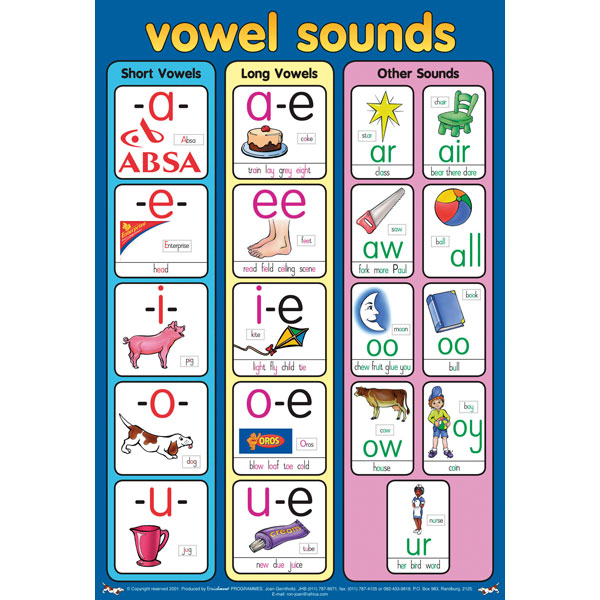 When children sing, "Oh, do you know the short a sound?", they can point to cats, apples, ants, an ax, a hat, and a basket. For long a, they will find Amos listening to the radio, holding a May calendar next to a table with cake, maple syrup, grapes, and plates. After children can remember all the vowel sounds, they can sing on their own with the instrumental version of the song and perhaps create their own short and long vowel pictures. They will also enjoy grouping objects that have the same vowel sounds or creating collages of magazine cut-outs. Keep a few copies of the book at a literacy center equipped with headsets so that students can gain practice in listening, singing, and remembering the sounds of the long and short vowels.
When children sing, "Oh, do you know the short a sound?", they can point to cats, apples, ants, an ax, a hat, and a basket. For long a, they will find Amos listening to the radio, holding a May calendar next to a table with cake, maple syrup, grapes, and plates. After children can remember all the vowel sounds, they can sing on their own with the instrumental version of the song and perhaps create their own short and long vowel pictures. They will also enjoy grouping objects that have the same vowel sounds or creating collages of magazine cut-outs. Keep a few copies of the book at a literacy center equipped with headsets so that students can gain practice in listening, singing, and remembering the sounds of the long and short vowels. - Using 3-letter or 4-letter words, explain the rule that when one vowel is in the middle of a word, it is usually short (Ex. bag, sit, bed). Print some of these words on a word wall. Pointing to an appropriate word, perform this rap to reinforce the short vowel rule: "Got one vowel in the middle of the word, got one vowel in the middle of the word, got one vowel in the middle of the word--Say /ă/, say /ă/, say /ă/ [clap-clap].
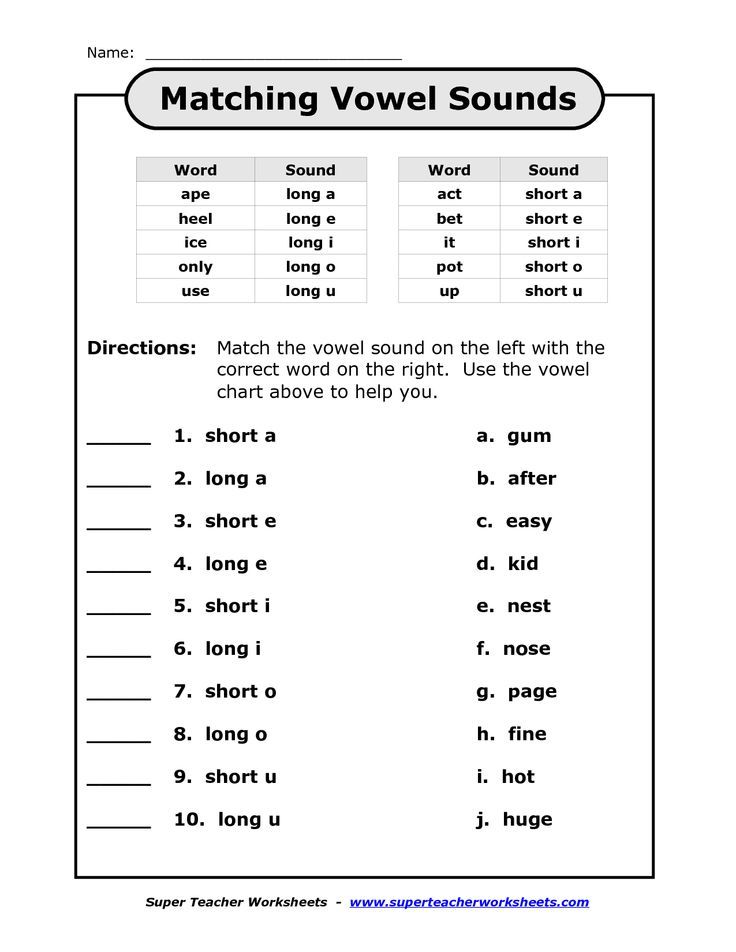 Repeat by pointing to another appropriate word and another short vowel sound until all short vowel sounds have been covered. Variations: Add back and forth side-steps while reciting the rap. Change the ending claps to taps, stomps, or knocks. Add rhythm instruments to help keep the beat.
Repeat by pointing to another appropriate word and another short vowel sound until all short vowel sounds have been covered. Variations: Add back and forth side-steps while reciting the rap. Change the ending claps to taps, stomps, or knocks. Add rhythm instruments to help keep the beat. - Find short vowel words in children's books and poems. Examples: From Shel Silverstein's Poetry in Where the Sidewalk Ends-Ickle Me, Pickle Me, Tickle Me, Too for short i; Jimmy Jet and his TV Set for short e. Singing games like The Banana Song (using the name Anna). Dr. Seuss' There's a Wocket in my Pocket and Fox in Sox for short o. Nursery Rhymes like Jack Sprat for short a; Diddle Diddle Dumpling for short i, short u, short o, and short e; Hickety-Pickety for short i and short e.
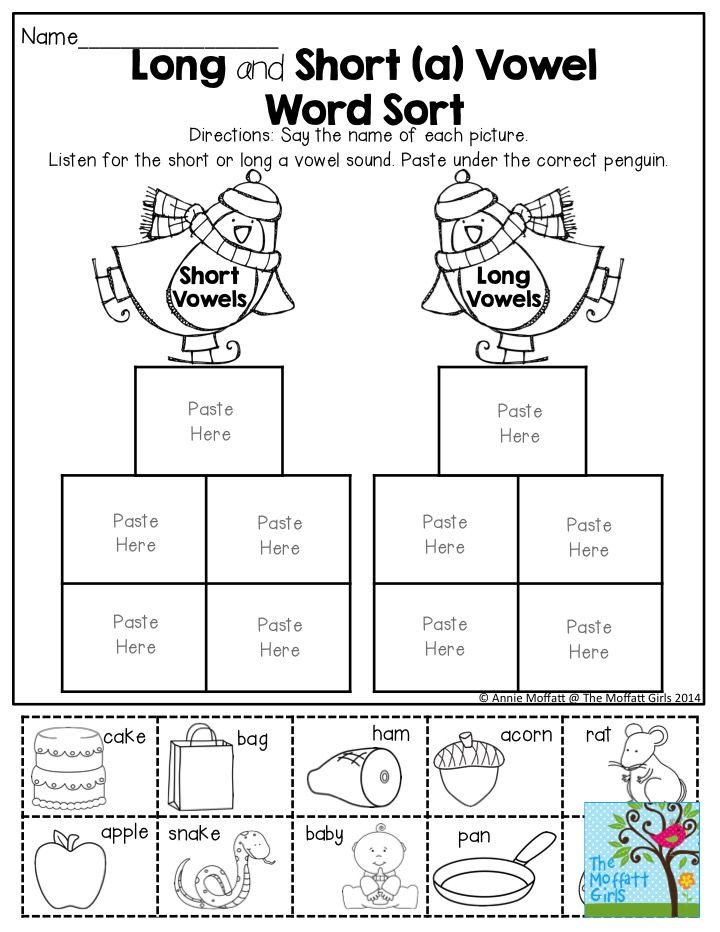
- Find short and long vowel sounds in students' names. Ex. Ann, Ellen, Jim, John, Buddy for short vowels; Jake, Steve, Mike, Joan, and Judy for long vowels.
- Find short and long vowel sounds in environmental words like Exit, Stop, Bus, In. Label classroom objects that illustrate short and long vowel sounds: dĕsk, chāir, tāble, gāme, pĕncils, pĕns, pāper, shĕlf, răck, lĕdge, ēasel.
- Have a Show-and-Tell time where children bring in objects with a particular short or long vowel sound. Place these or other objects on a table labeled with that vowel and the short or long symbol.
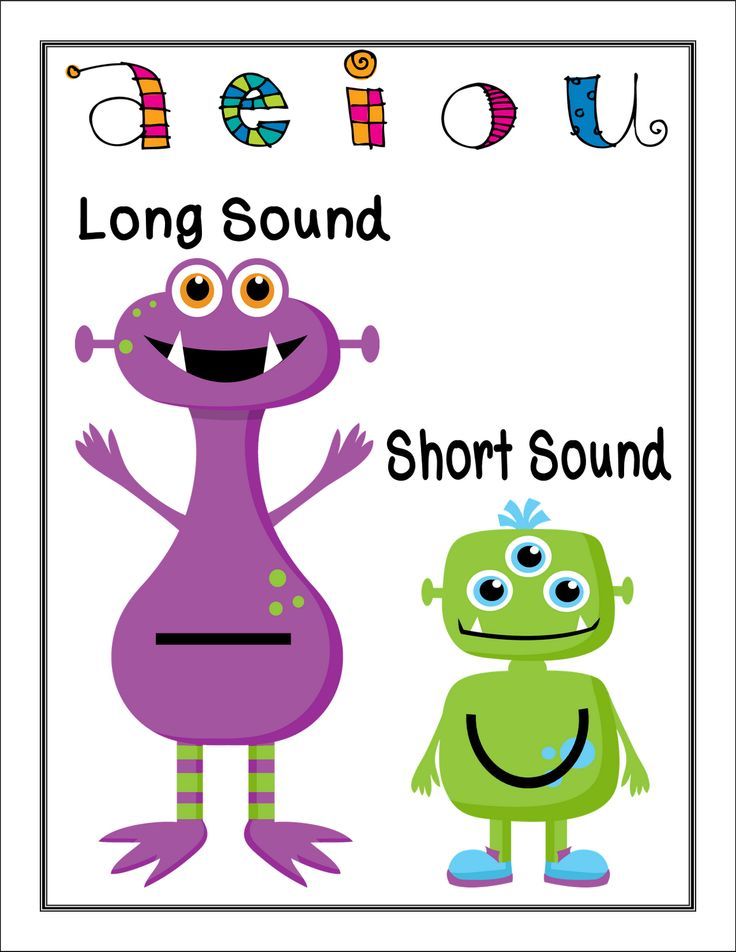
Evaluation:
- Students can produce the correct short vowel and long vowel sounds on Mini-Charts pp.41-46 without assistance.
- Students pass a written or manipulative test where they match pairs of short vowel pictures and long vowel pictures.
Order our cost-saving Sing Your Way Through Phonics Volume 1 Combo online ($33.95) containing the CD, Mini-Charts, Song Lyrics, and Teaching Suggestions — everything you need for this lesson! Or, print out an order form to mail/FAX to us.
IPA English Vowel Sounds Examples
By Georgie Harding – Founder & Head Speech Pathologist
English Vowel Sounds IPA Examples – With Practice Exercises
Voice Recorder, Video & Audio Files to Practice Your Vowel Sounds
Today, you’ll see English vowels examples of the IPA for each vowel, and to improve your pronunciation you’ll complete English vowel exercises and practice.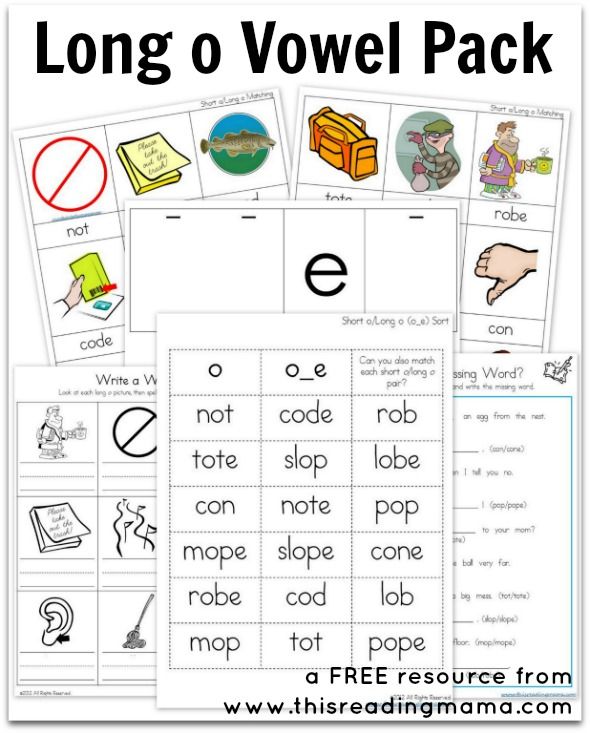 Listen to each vowel sound pronounced by a native English speaker, practise your pronunciation of each vowel sound and download our English Vowel Sounds Chart.
Listen to each vowel sound pronounced by a native English speaker, practise your pronunciation of each vowel sound and download our English Vowel Sounds Chart.
See this English Vowel Lesson Video to practice all the vowels in English.
What are the English Vowel Sound IPA symbols (International Phonetic Alphabet)? English has 20 vowel sounds. Short vowels in the IPA are /ɪ/-pit, /e/-pet, /æ/-pat, /ʌ/-cut, /ʊ/-put, /ɒ/-dog, /ə/-about. Long vowels in the IPA are /i:/-week, /ɑ:/-hard,/ɔ:/-fork,/ɜ:/-heard, /u:/-boot. Diphthong vowels in the IPA are /eɪ/-place, /oʊ/-home, /aʊ/-mouse, /ɪə/-clear, /eə/-care, /ɔɪ/-boy, /aɪ/-find, /ʊə/-tour.
I understand that to many people that can look a little overwhelming.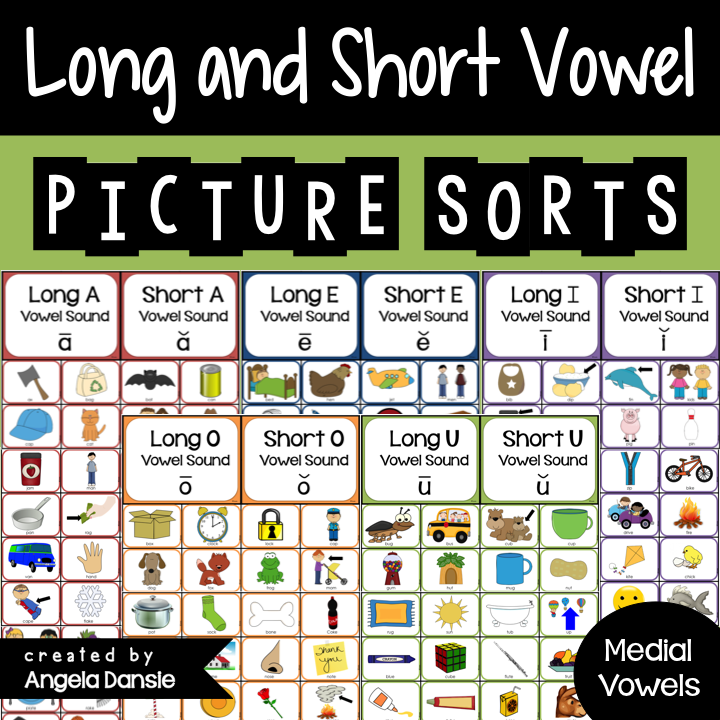 But I promise it’s not so bad. We’ll break it down and give you real examples and practise.
But I promise it’s not so bad. We’ll break it down and give you real examples and practise.
If you want to know more about how to actually use the symbols to improve your pronunciation and English accent, see our guide for learners on using the IPA – “English Pronunciation – How to Use the IPA To Improve”
Before we start, let’s cover some International Phonetic Alphabet (IPA) basics.
What is the International Phonetic Alphabet (IPA) used for? Learners of foreign languages use the IPA to check exactly how words are pronounced. Each IPA symbol represents a sound. For example, a learner of English can use the IPA to find out exactly what sounds are in a word and where the word stress is. It is an extremely helpful tool for people learning to speak another language.
Why is the IPA important for learning English pronunciation? The International Phonetic Alphabet (IPA) is very important for learners of English because English is not a phonetic language. The spelling of an English word doesn’t tell us how to pronounce it. In English, several different letter combinations can be used to spell the same sound and there are silent letters. The IPA tells us the correct sounds and word stress for pronouncing English words.
The spelling of an English word doesn’t tell us how to pronounce it. In English, several different letter combinations can be used to spell the same sound and there are silent letters. The IPA tells us the correct sounds and word stress for pronouncing English words.
What’s the difference between a short vowel, a long vowel and a diphthong vowel in the IPA in the dictionary? When you look at the English Vowel Sounds IPA symbols in the dictionary one symbol by itself is a short single vowel, two dots like this /:/ after a vowel symbol mean that it is a long single vowel and two vowel symbols, one after the other means a double or diphthong vowel.
Here is an example IPA of what English Vowel Sounds IPA symbols look like in the dictionary.
In this page we will revise all the English vowel phonetic symbols. We have broken these up into English vowel phonetic symbols for short vowels, long vowels and double or diphthong vowels.
Let’s look at the English vowel sounds IPA symbols more closely, starting with short vowels.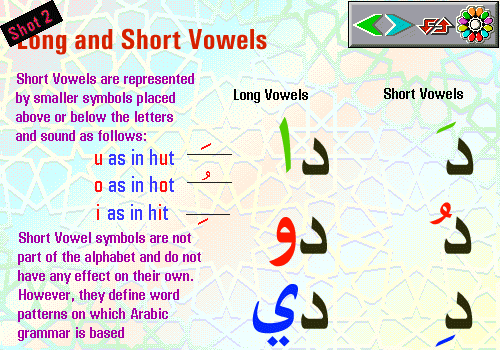
English Short Vowels in the IPA (International Phonetic Alphabet)
What you need to know about .
– a short English vowel is noticeably shorter than a long vowel
– an English short vowel is made with only one mouth position
– one mouth position is represented by one IPA symbol (every sound /mouth position has a different IPA symbol)
– the weak vowel schwa is the most common vowel in English.
What Are the English Short Vowels in the IPA? There are 7 IPA symbols for English short vowels. The IPA for English short vowels are: /ɪ/, /e/, /æ/, /ʌ/, /ʊ/ , /ɒ/, /ə/
English Vowels Examples – IPA Short Single VowelsVowel Phonetic Symbol & IPA Examples in Words
/ɪ/ – fit /fiːt/, pick /piːk/, difficult /ˈdɪ.fɪ.kəlt/
/e/ – pet /pet/, sent /sent/, attention /əˈten.ʃən/
/æ/ – pat /pæt/, flat /flæt/, family /ˈfæ.mə.li/
/ʌ/ – cut /kʌt/ jump /dʒʌmp/, cover /ˈkʌ.vər/
/ʊ/ – put /pʊt/, book /bʊk/, cushion /ˈkʊ.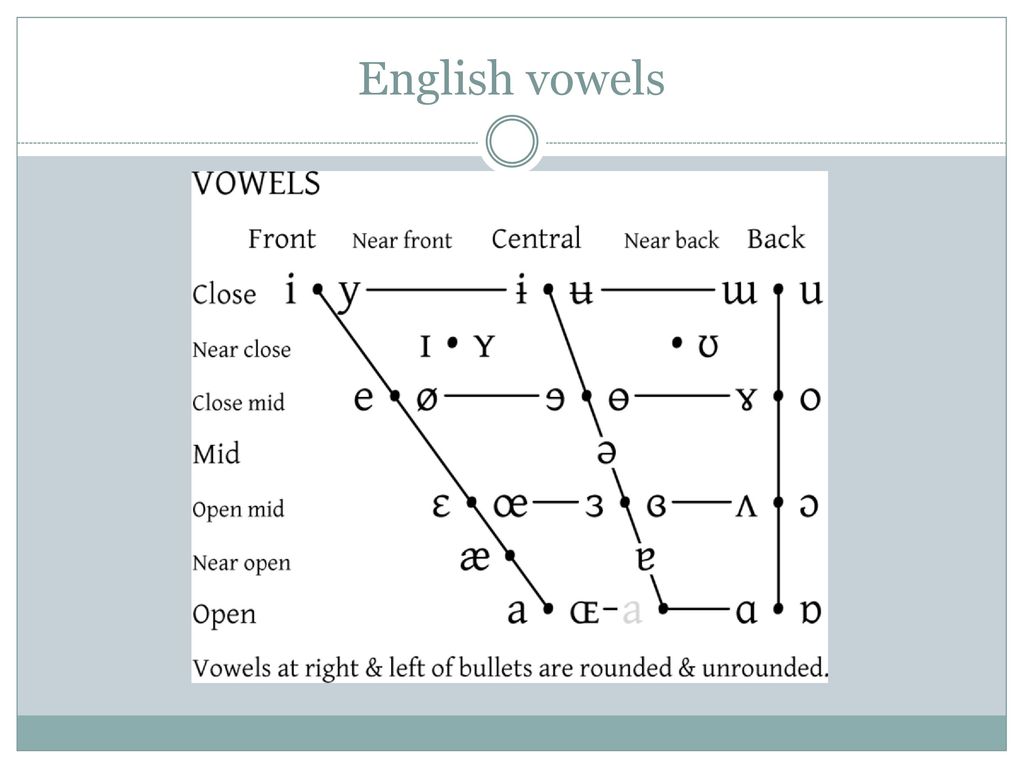 ʃən/
ʃən/
/ɒ/ – pot /pɒt/, dog /dɒg/, hospital /ˈhɒs.pɪ.təl/
/ə/ – about /əˈbaʊt/, system /ˈsɪs.təm/, complete /kəmˈpliːt/.
More Examples of English Short Vowels in the IPA – Listen & Record
See the IPA symbol for each vowel at the top of each blue box. Complete each of the English Vowels exercises with the voice recorder and practise English vowels phonetics.
See the phonetic symbol for each vowel sound, see International Phonetic Alphabet examples in 4 commonly used words, click to hear it pronounced and record your own pronunciation.
Click to below to hear English vowels exercises on short English vowel phonetics.
/ɪ/
hit /hɪt/ pick /pɪk/
miss /mɪs/ tip /tɪp/
/e/
let /let/ neck /nek/
mess /mes/ wet /wet/
/æ/
sat /sæt/ back /bæk/
hat /hæt/ cap /kæp/
/ɒ/
hot /hɒt/ sock /sɒk/
boss /bɒs/ top /tɒp/
/ʌ/
cut /kʌt/ luck /lʌk/
fuss /fʌs/ cup /kʌp/
/ʊ/
put /pʊt/ look /lʊk/
cook /kʊk/ good /gʊd/
/ə/ – schwa
apart/əˈpɑːt/ pilot /ˈpaɪ. lət/
lət/
carrot /ˈkæ.rət/ minute /ˈmɪ.nət/
Join Our 5 Day Free English Pronunciation Online Course
English Long Vowels in the IPA
What you need to know.
– English long vowels have two dots like this – /:/ after the vowel symbol. If it has /:/ after it, you know it’s a long vowel!
– English long vowels are noticeably longer than short vowels.
– distinguishing between short and long vowels is very important in English because they mean different words. eg ship and sheep, sh*t and sheet, wick and week and so on.
– an English long vowel is only one symbol in the IPA because it is one mouth position.
KEY POINT: When you are looking at the vowels in the IPA to help you with your pronunciation, if you see the two dots /:/ you need to check you are making a long vowel, not a short vowel or a double vowel.
English Vowel Examples – IPA Long Single Vowels
Vowel Phonetic Symbol & IPA Examples in Words
/i:/ week /wi:k/, feet /fi:t/, media /ˈmiː.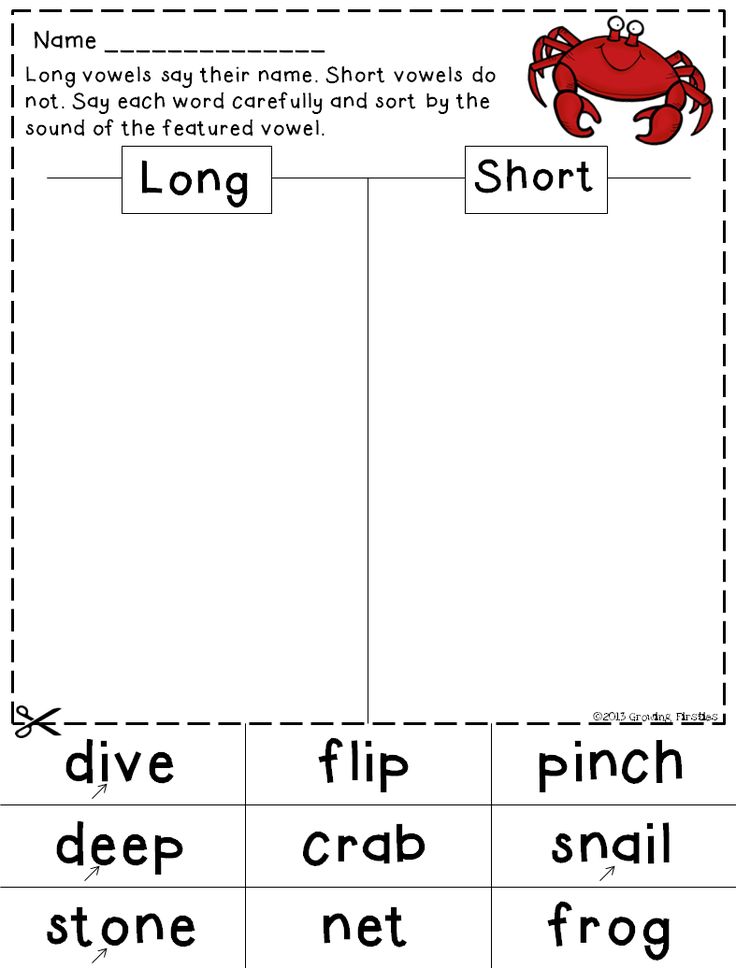 di.jə/
di.jə/
/ɑ:/ hard /ha:/, park /pa:k/, article /ɑː.tɪ.kəl/
/ɔ:/ fork /fɔ:k/, walk /wɔ:k/, August /ɔːˈɡʌst/
/ɜ:/ heard /hɜ:d/, word /wɜ:d/, surface /ˈsɜː.fɪs/
/u:/ boot /bu:t/, group /gru:p/, beautiful /ˈbjuː.tɪ.fəl/
What are English Long Vowels in the IPA? There are 5 IPA symbols for English long vowels. The IPA for English long vowels are: /i:/, /ɑ:/, /ɔ:/, /ɜ:/, /u:/.
More Examples of Long English Vowels in the IPAUse the boxes below to revise and practise each of the long English vowels phonetics.
See the phonetic symbol for each vowel sound at the top of each box, see IPA vowel examples of it in 4 common English words, click to hear it pronounced and record your own pronunciation.
ACHTUNG!
As you listen to the IPA examples and practise out loud, pay careful attention to the length of each vowel.
Many non-native speakers of English make many of these vowels too short!
Before you start with the activties below say the words below out loud and pay attention to the length of the vowel.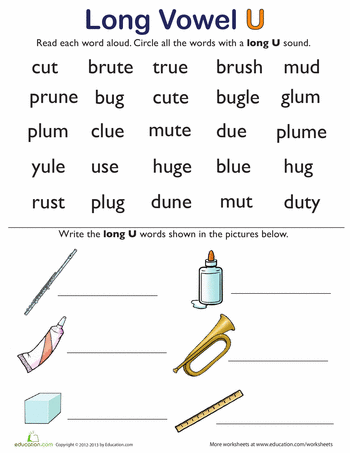
Here are some examples of long vowels in contrast with a shorter version, which actually means another word!
Notice that the long vowels all have the two dots /:/. All of these short vowels and long vowels are SINGLE vowels – they ony have one IPA vowel symbol. This means they only have one mouth position.
Short Vowel vs Long Vowel
hit /hɪt/ – heat /hiːt/
pick /pɪk/ – peak /piːk/
lick /lɪk/ – leak /liːck/
duck /dʌk/ – dark /da:k
stuff /stʌf/ – staff /sta:f/
When completing this English vowels practice, make sure you are clearly making a short vowel and a long vowel. For example, heat and hit should sound different. Peak and pick should sound different. Duck and dark – should sound different.
If they are sounding the same, do some more English vowels practise with the IPA Short Vowel Examples and the IPA Long Vowel Examples until you can more easily hear and make the right vowel length.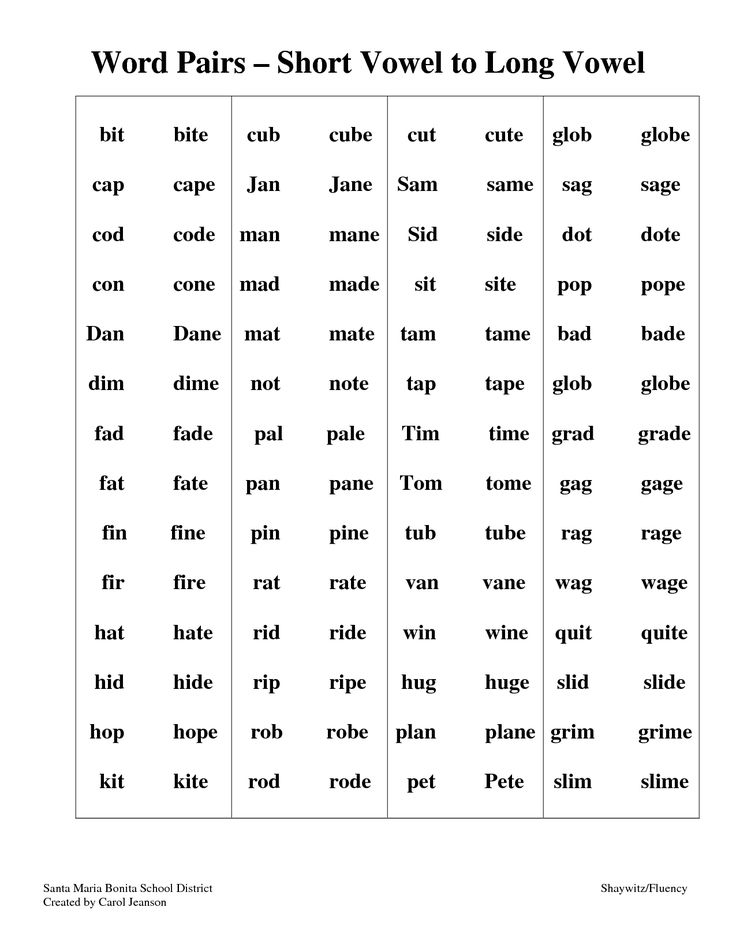
Click to below to listen to English vowels exercises on long English vowel phonetics with IPA.
/i:/
heat /hi:t/ peak /pi:k/
piece /pi:s/ leak /li:k/
/a:/
start /sta:t/ dark /da:k/
glass /gla:s/ laugh /la:f/
/u:/
suit /su:t/ threw /θruː/
juice /dʒuːs/ room /ruːm/
/ɔ:/
caught /kɔ:t/ pork /pɔ:k/
horse /hɔ:s/ form /fɔ:m/
/ɜ:/
hurt /hɜ:t/ work /wɜ:k/
nurse /nɜ:s/ sir /sɜ:/
See an example of how long vowels are shown in English dictionaries in the diagram below. This IPA example is from the free Cambridge Online Dictionary. The Cambridge Online Dictionary is an excellent reliable and free online dictionary that you can use to see the IPA for English words.
The Cambridge Online Dictionary is very helpful because it shows the IPA for British English and American English and you can listen to the pronunciation of each word in an American and British accent.
See the screen shot below of how English long vowels are shown in the IPA in the dictionary. I’ve labelled the marker for Word Stress in the IPA and also schwa. Schwa is the name of this symbol /ə/, it’s the most important weak vowel in English.
You’ll see that after the symbol for the vowel /ɔ/ there’s two dots /:/. These two dots show that the vowel is long.
English Diphthong or Double Vowels in the IPAWhat you need to know.
– English diphthong vowels have two IPA symbols because they are made up of two mouth position.
– in other words, diphthong vowels are two short vowels joined together, they are also called double vowels.
– many non-native speakers make some English diphthong vowels as single vowels
Vowel Phonetic Symbol & IPA Examples in Words
/eɪ/ place /pleɪs/, late /leɪt/, dangerous /ˈdeɪn.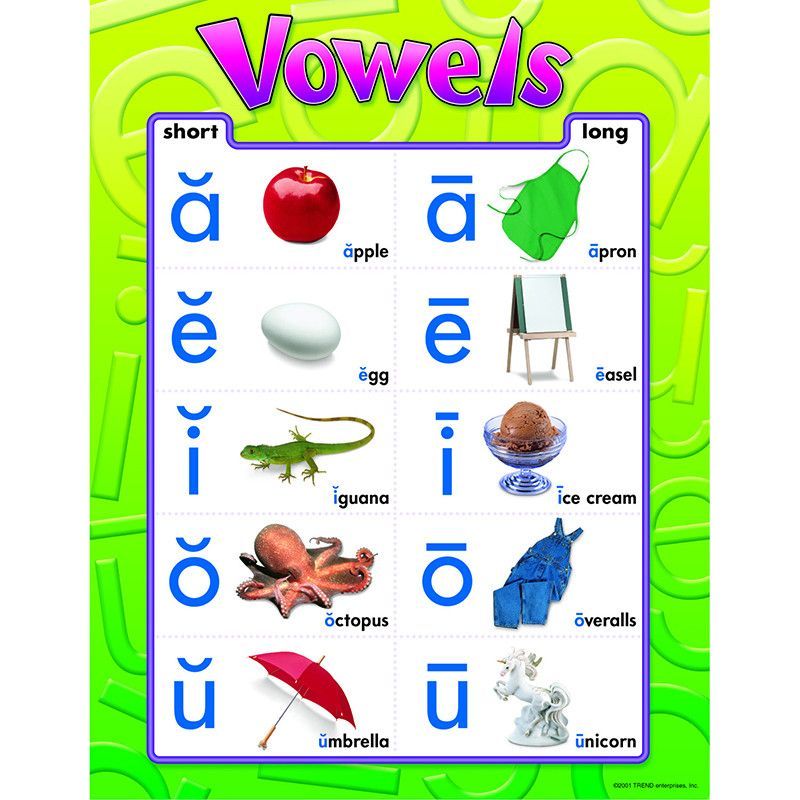 dʒə.rəs/
dʒə.rəs/
/oʊ/ home /hoʊm/, phone /foʊn/, global /ˈɡloʊ.bəl/
/aʊ/ mouse /maʊs/, brown /braʊn/, accountant /əˈkaʊn.t̬ənt/
/ɪə/ clear /klɪə/, fear /fɪə/, career /kəˈrɪə/
/eə/ care /keə/, wear /weə/, declare /dɪˈkleə/
/ɔɪ/ boy /bɔɪ/, toy /tɔɪ/, enjoyable /ɪnˈdʒɔɪ.jə.bəl/
/aɪ/ find /faɪnd/, bite /baɪt/, tiger /ˈtaɪ.ɡə/
/ʊə/ tour /tʊə/, pure /pʊə/, mature /məˈtʃʊə/
What are English Diphthong Vowels in the IPA? There are 8 IPA symbols for English Diphthong vowels. The IPA for English Diphthong vowels are: /eɪ/, /oʊ/, /aʊ/, /ɪə/, /eə/, /ɔɪ/, /aɪ/, /ʊə/.
More English Vowels Examples -IPA Diphthong Vowels
Use the boxes below to revise and practise each of the English vowels phonetics for double vowels in English.
See the phonetic symbol for each vowel sound at the top of each box, see IPA vowel examples of it in 4 common English words, click to hear it pronounced and record your own pronunciation.
ACHTUNG!
As you listen to the IPA examples, listen carefully to hear the two vowel sounds in each.
Can you hear the two vowels?
Many people make a single vowel, instead of a double vowel. This happens because the English double vowel doesn’t exist in their first language.
This makes many of their words unclear. For example, when they say ‘coat’ it sounds more like ‘cot’, when they say ‘note’ it sounds more like ‘not’, when they say ‘won’t’ it sounds more like ‘want’ – Video on pronouncing ‘won’t’ vs ‘want’.
As you go through, feel the two positions in each double vowel.
Click to below to hear English vowels exercises on double / diphthong English vowel pronunciation with English vowel phonetics.
/aɪ/
light /laɪt/ like /laɪk/
rice /raɪs/ ripe /raɪp/
/eɪ/
late /leɪt/ lake /leɪk/
race /reɪs/ train /treɪn/
/ɔɪ/
boy /bɔɪ/
join /dʒɔɪn/ choice /tʃɔɪs/
noise/nɔɪs/
/aʊ/
about /əˈbaʊt/
found /faʊnd/ house /haʊs/ down /daʊn/
/oʊ/
note /noʊt/ coke /koʊk/ hose /hoʊs/ phone /foʊn/
/ɪə/
hear /hɪə/ near /nɪə/
fear /fɪə/ beer /bɪə/
/eə/
hair /heə/ share /ʃeə/
pear /peə/ chair /tʃeə/
/ʊə/
tour /tʊə/ lure /lʊə/
cure /kʊə/ pure /pʊə/
See English Diphthong Vowels in the IPA in the dictionary.
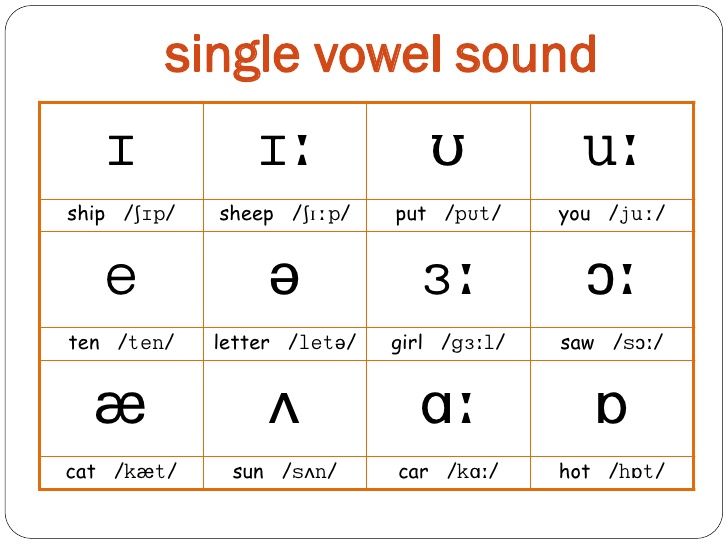
See an example of how diphthong vowels or double vowels are shown in dictionaries in the diagram below.
This IPA example is from the free Cambridge Online Dictionary. The Cambridge Online Dictionary is a reliable and free site that you can use to check the pronunciation of English words.
It shows the IPA for American English and British English and you can click to hear the word pronounced in both American and British accents.
See a screen shot of how English diphthong and double vowels are shown in the IPA in the dictionary below. I’ve labelled the marker for Word Stress in the IPA and also schwa, the most important weak vowel in English.
English Vowel Sounds Chart PDFHere is a clear English Vowel Sounds Chart with IPA Symbols.
Many ESL speakers find this English Vowel Sounds Chart extremely helpful.
English Vowels Sounds Chart pdf.
Download English Vowel Sounds Chart PDF here
Join Our Free English Pronunciation Starter Course For More English Vowels PracticeAfter your English vowels practice from today, you might be wondering why certain vowels are more difficult than others.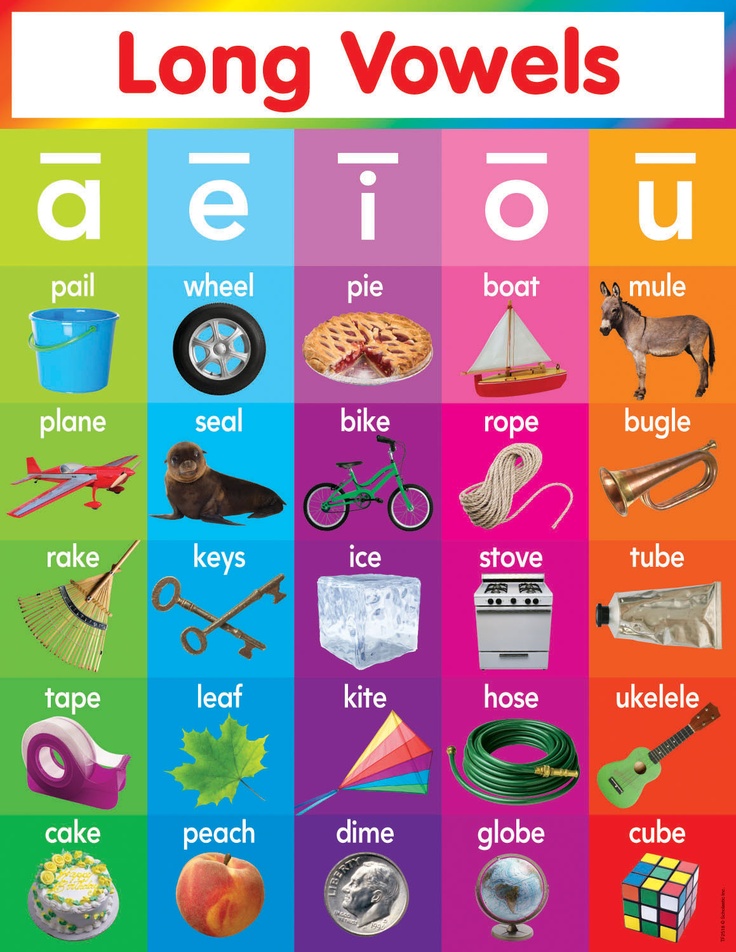 Which vowels you find challengings depends on your first language. You can find out more about which vowels speakers of your first language find difficult and continue your English vowels practice with our free 5 day English Pronunciation Course,
Which vowels you find challengings depends on your first language. You can find out more about which vowels speakers of your first language find difficult and continue your English vowels practice with our free 5 day English Pronunciation Course,
You’ll receive 5 emails full of excellent English pronunciation videos. Learn priority areas for clearer, better spoken English, record a clear professional voicemail greeting, English vowels exercises, improve your word stress, correct lots of commonly mispronounced words.
|
☑ By signing up you are agreeing to receive further information and tips from Speech Active.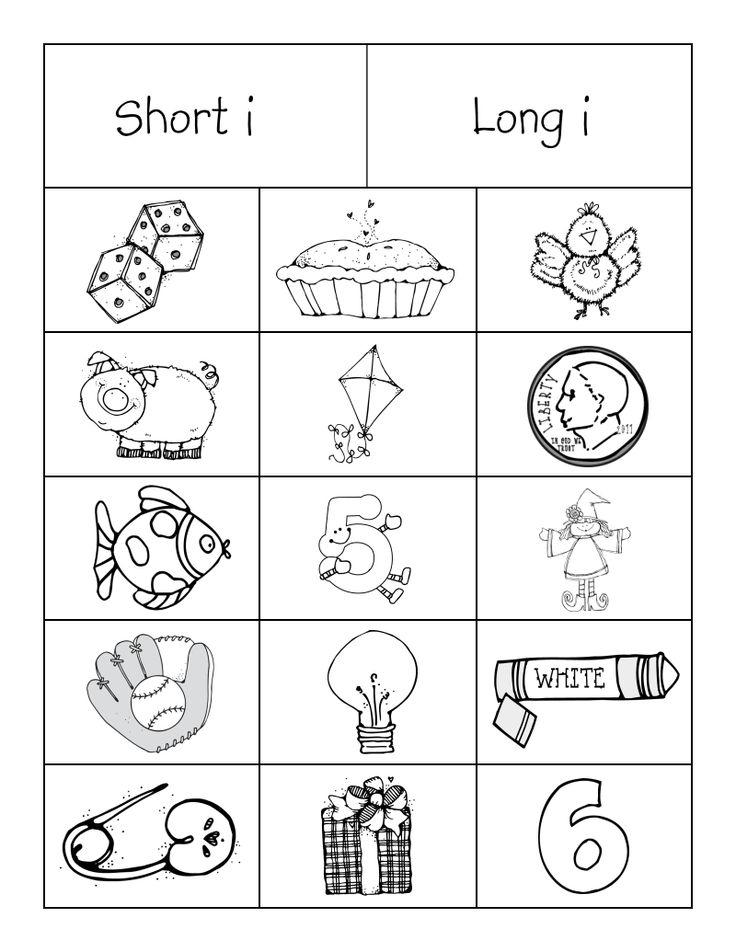
And there you have it!
All the English Vowel Sounds IPA, clearly shown with each International Phonetic Alphabet Symbol.
These English vowels exercises have hopefully helped you become more aware of which English vowel sounds you need to improve on for clearer, better spoken English.
I hope the images and information in this article will help you understand the International Phonetic Alphabet (IPA) for English Vowels and how to use the IPA to improve your pronunciation of vowel sounds in English.
The IPA is a powerful tool that can be seriously helpful to learners.
Georgie's Tips For Using The IPA (International Phonetic Alphabet) To Improve Your Pronunciation:
Remember that even if you don't know every symbol you should still use the IPA for important information such as:
- the /:/ tells you when there is a long vowel
- two symbols means it's a double or diphthong vowel
- /'/ is for word stress and tells you the next syllable is stressed
All the best.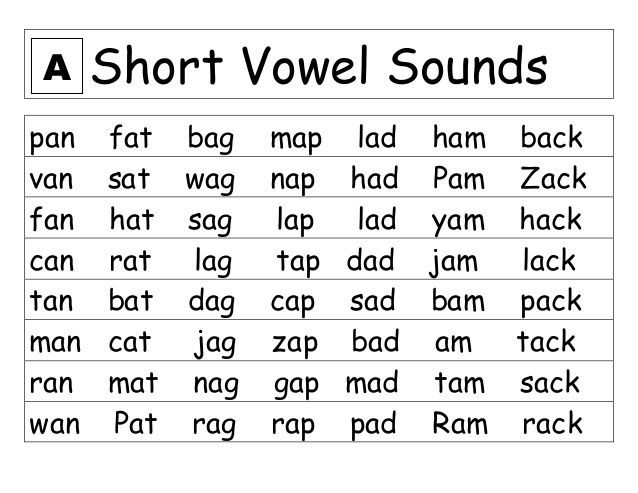
x
Georgie
by Georgie
Georgie Harding has assisted thousands of people from all over the world with improving their clarity and spoken English skills. A Speech Pathology degree (BAppSc(SpPath) and CELTA qualifications and over 15 years of experience providing 1:1, group and online training make Georgie a leader in her field.
Georgie is the creator the world's leading English Pronunciation online courses that are tailored to the language background of the student and presents regularly at Universities.
If you've ever met Georgie or completed her award winning courses you'll know how passionate she is about helping people move forward with better spoken English and more confidence.
Email: [email protected]
Linkedin: Georgie Harding
Facebook: Speech Active
Twitter: Speech Active
|
☑ By signing up you are agreeing to receive further information and tips from Speech Active.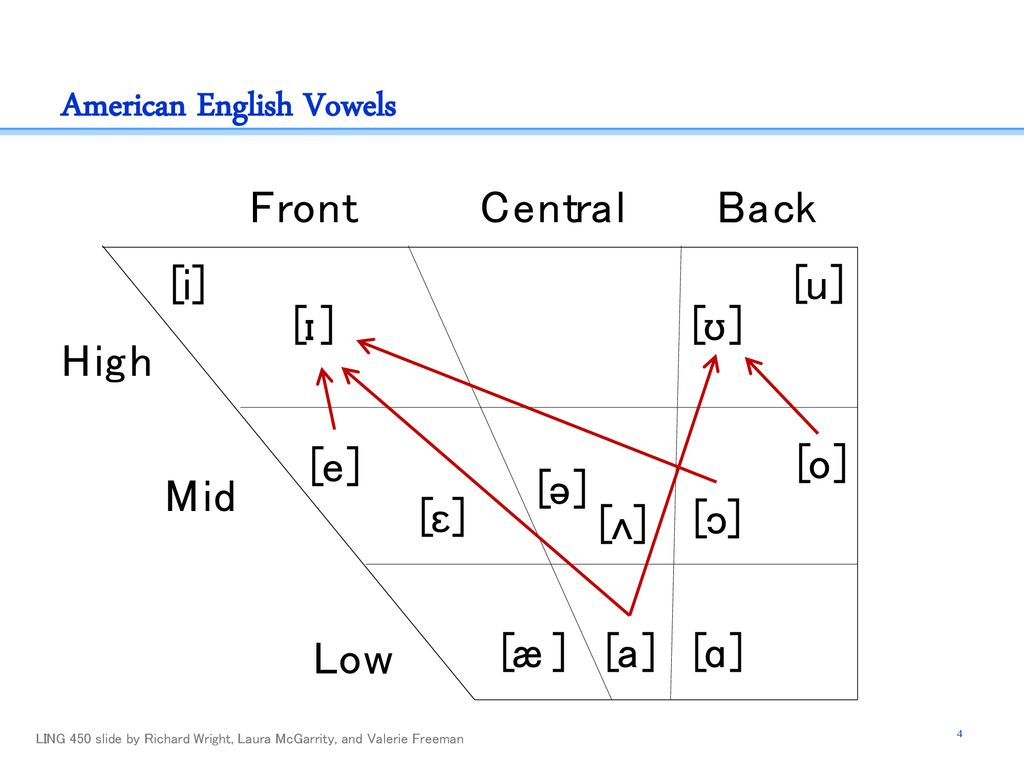
5 emails - start today
Your step-by-step path to clear and confident English
Start Now
Long and short vowels in English
Longitude is one of the characteristics of a vowel sound, which shows the relative duration of its sound compared to other sounds.
Longitude can be positional and phonemic. In the first case, the duration of the vowel depends on the position in the word and stress, while this characteristic does not affect the meaning. The phonemic length of a vowel has a semantic function, that is, depending on the length of the sound, the meaning of the word changes.
Length of vowel sounds in English
In Russian, the length of vowel sounds does not affect the meaning of words and changes only depending on stress. In English, vowels differ not only in positional but also in phonemic length. This means that long and short sounds, similar in other characteristics, represent different phonemes. Words that differ only in these phonemes have different meanings: ship - sheep , fit - feet , pull - pool . Therefore, it is so important to pronounce long and short sounds correctly.
Words that differ only in these phonemes have different meanings: ship - sheep , fit - feet , pull - pool . Therefore, it is so important to pronounce long and short sounds correctly.
In transcription, long vowels are indicated with a colon: [i:], [α:], [ɔ:], [u:], [ә:]. In some cases, long vowels in an unstressed position are reduced and become semi-long, which in transcription is indicated by one dot from above: [α ].
The long vowels listed above are opposed to short vowels, forming the following pairs in English:
- [i:] - [ı]
- [uː] - [u]
- [ɔ:] - [ɒ]
- [α:] - [ʌ]
- [ә:] - [ə]
The pronunciation of long and short English vowels often causes difficulties for Russian learners of English, since in Russian vowels do not have phonemic longitude, and we are not used to distinguishing the length of a vowel sound by ear. We often do not hear the difference between long and short vowels when listening to English speech.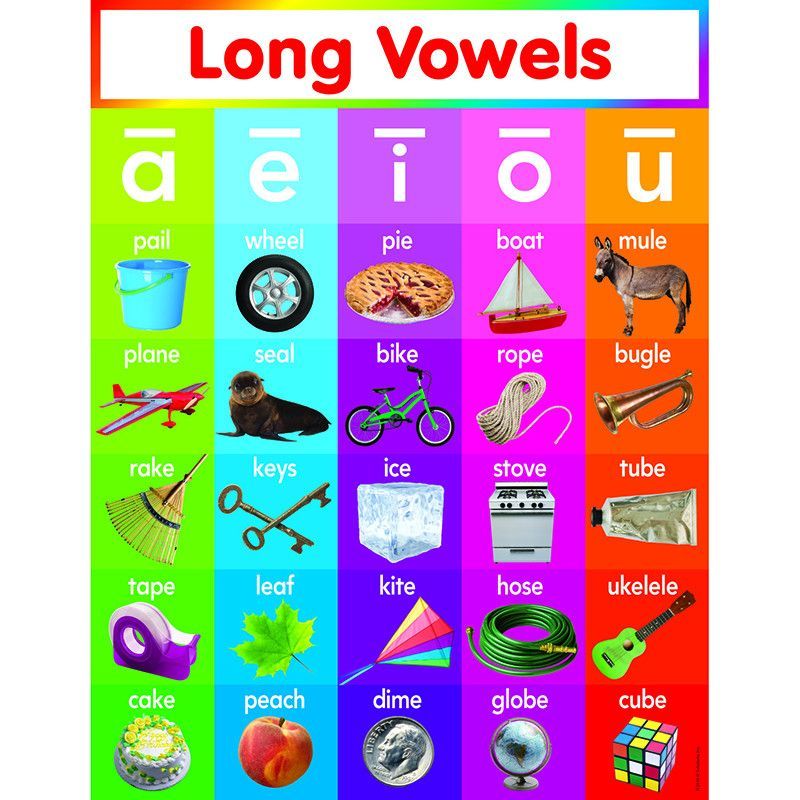 It is still not clear how long you need to draw a sound when speaking, so very unnatural, or almost inaudible, or too long vowels are obtained. It is impossible to correctly pronounce short and long sounds so that a native speaker hears the difference, even if you diligently shorten short vowels and stretch out long ones.
It is still not clear how long you need to draw a sound when speaking, so very unnatural, or almost inaudible, or too long vowels are obtained. It is impossible to correctly pronounce short and long sounds so that a native speaker hears the difference, even if you diligently shorten short vowels and stretch out long ones.
Sometimes it seems that native speakers themselves do not know the difference between short and long sounds, they seem to pronounce them the same way - but they themselves understand each other. But it's not. Let's see what are the differences between long and short English vowels, how to learn to hear them and how to train their pronunciation.
Differences between long and short English sounds
It is logical to assume that if vowels are called long or short, they differ in sound length. This is the main difference between them, but not the only one. It is important to understand that long and short sounds have other differences, which consist in articulatory features. This means that the sounds are not just of different lengths, they are also different in sound. And most often it is these articulatory features that determine the length of the vowel sound: the duration of the sound depends on the position of the tongue and the tension of the vocal apparatus.
This means that the sounds are not just of different lengths, they are also different in sound. And most often it is these articulatory features that determine the length of the vowel sound: the duration of the sound depends on the position of the tongue and the tension of the vocal apparatus.
Long and short English vowels differ in such a characteristic as tension. Long vowels are tense, in English they are also called tense . When they are pronounced, the root of the tongue seems to be tense, under tension. The sound is pronounced, bright, rich, clear.
Short vowels are called lax – relaxed. The tongue in the region of the root is relaxed, the vowel sound is articulated quickly, easily, without additional effort, as if bursting. It turns out short, inconspicuous, faded and fuzzy.
Qualitative differences in sounds in different pairs of English vowels range from pronounced to almost imperceptible. It is easy to notice the difference between long and short sounds a: pay attention to how the words cart and cut are pronounced, they differ not only in duration, but also in sound.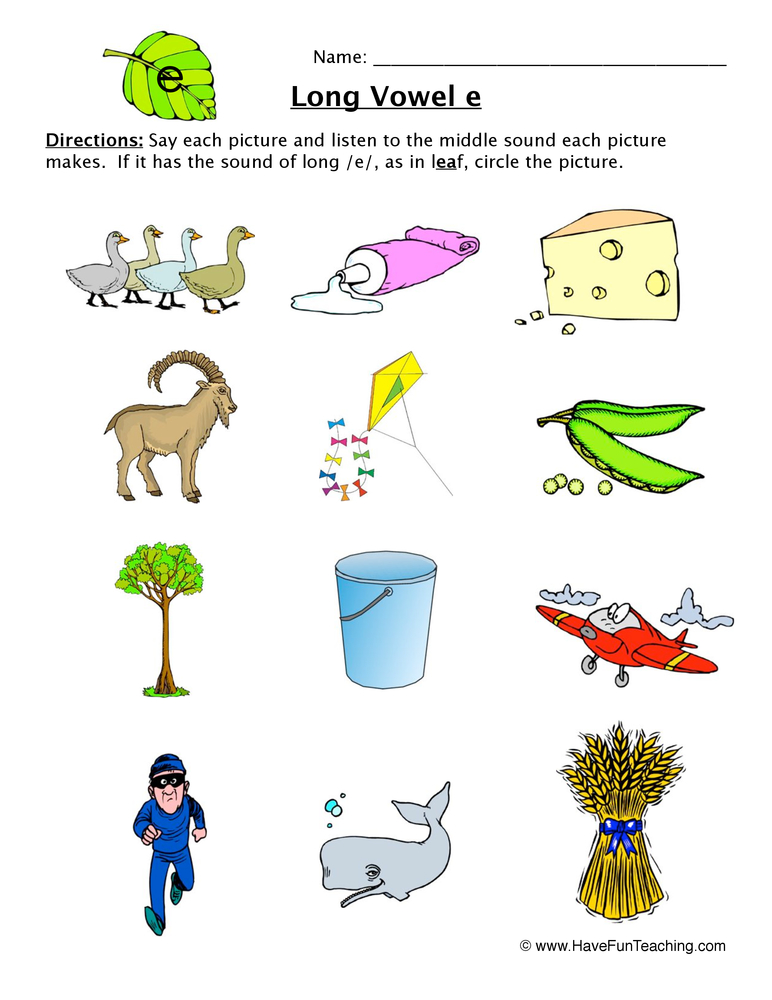 But the differences between long and short u are almost imperceptible: pool and pull sound very similar, only slightly different in length. The Scots generally pronounce them the same way, differing only in context.
But the differences between long and short u are almost imperceptible: pool and pull sound very similar, only slightly different in length. The Scots generally pronounce them the same way, differing only in context.
In addition, the duration of the pronunciation of vowels is also affected by positional longitude - for example, stressed or unstressed position in a word. As a result, a short vowel sound in one word may sound longer than a long sound in another word.
Thus, it is not enough to rely only on the subjective duration of a vowel sound. All the features of short and long vowels described above must be taken into account when learning English. It remains to understand how to master the pronunciation of long and short sounds in practice.
How to learn to pronounce long and short English vowels
The main mistake foreigners make when pronouncing long and short English sounds is focusing only on duration. But with this approach, it is intuitively incomprehensible where the boundary between a long and a short sound passes: you can’t measure the length of a sound with a stopwatch.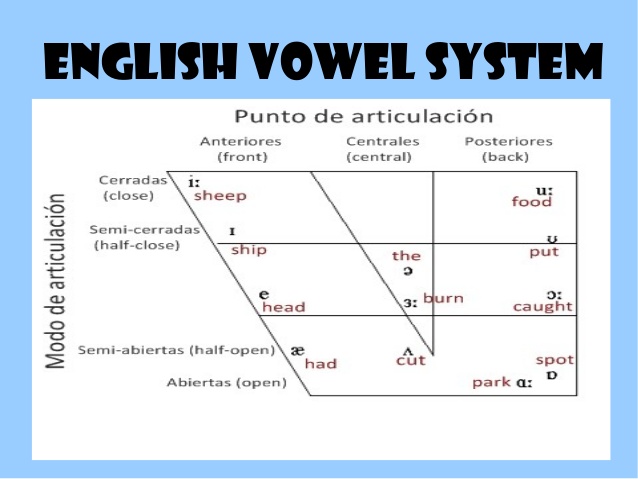 When trying to artificially lengthen or shorten a vowel, the sounds are unnaturally short or drawn out.
When trying to artificially lengthen or shorten a vowel, the sounds are unnaturally short or drawn out.
To learn how to pronounce long and short English sounds, you need to forget about the usual terminology "long" and "short". Try not to think about the duration of the sound at all. To correctly pronounce long and short vowels, you need to focus on their articulation, and not on duration. If we correctly reproduce the pronunciation of the vowel, then the duration will turn out to be correct automatically. Remember that long vowels require more tension at the root of the tongue, while short ones are pronounced without additional effort, easily and without tension.
Pay attention to how native speakers pronounce vowels - don't watch how long they draw them out, but watch the pronunciation, the articulation, the quality of the sound. Repeat, imitate, practice. For practice, it is best to use video lessons or a conversation with a native speaker, since audio materials do not make it possible to see articulation.
It is best to train long and short sounds not separately, but as part of words. First, this way you will note the influence of positional longitude on the duration of the sound in specific examples. Secondly, just as words are best learned in context, sounds are also best learned in the environment.
Practice pronunciation of long and short vowels in pairs of words to notice the difference between sounds, for example:
- Sport – hot
- Arm-cut
- See-hit
- Food-put
- Fur – ago
When you learn how to pronounce long and short vowels correctly in English, it will become easy to distinguish between them in speech. When listening to speech, forget about the differences in duration, pay attention to the qualitative differences in sounds - how intensely the vowel is pronounced, how bright or faded it sounds, how pairs of sounds differ from each other, except for duration.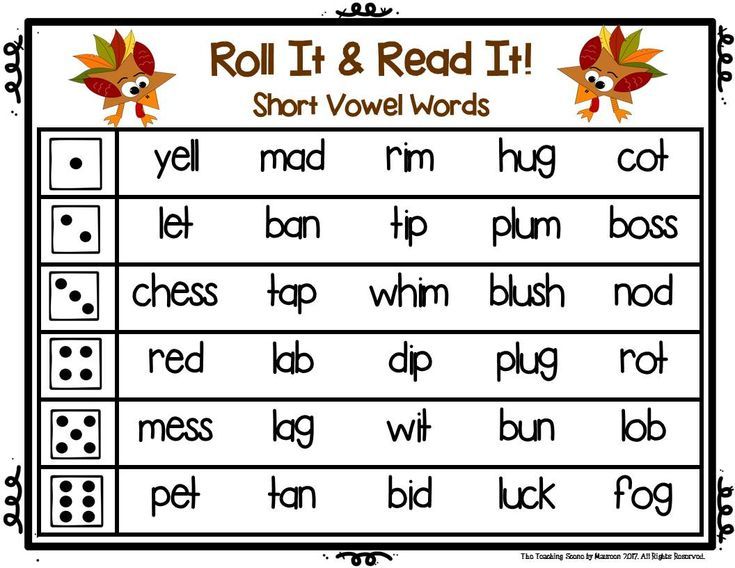
Long and short vowels in German: long and short sounds
Photo: suju / pixabay.com
So, voiceless and voiced consonants can form pairs. What about vowels? Of course, vowels cannot be voiceless or voiced, but they can be pronounced long or short and form pairs in longitude. Let's see how it works in German!
What are long and short vowels for?
In modern Russian and most Slavic languages, all vowels are pronounced short, and their lengthening may seem strange or even funny to us (for example, in Finnish or Estonian).
Long and short vowels are common in German and English. Their sound is not as noticeable as in the languages from the example above, but it is extremely important in conversation and perception of oral speech. The thing is that two words that are completely different in meaning can differ in a single, long or briefly pronounced letter.
For example:
Long and short vowels in German: basic rules
There are a whole bunch of rules on this topic that have one thing in common: it seems incredible to fit them in your head and apply them.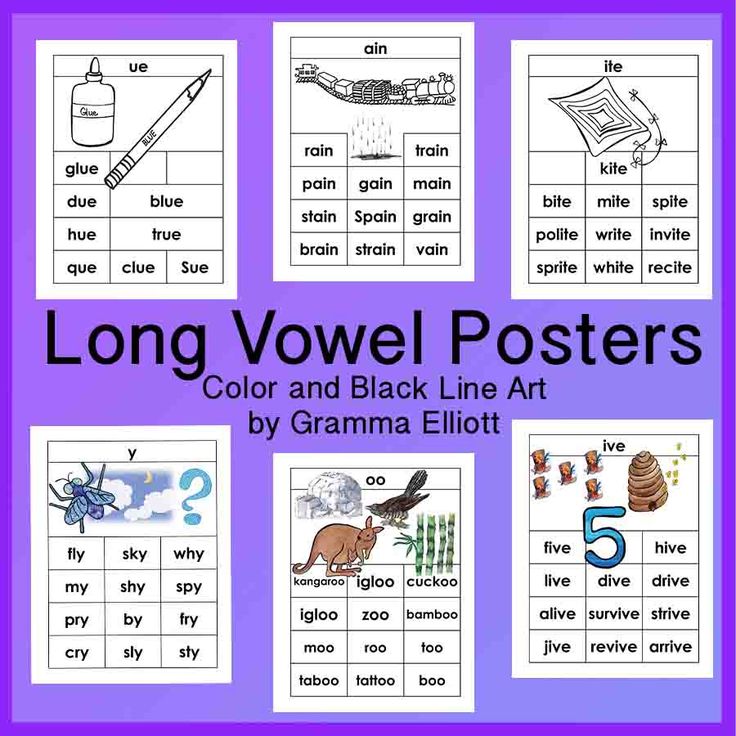 Let's try to figure it out so that you remember most of it the first time!
Let's try to figure it out so that you remember most of it the first time!
Long and short vowels in stressed and unstressed syllables
Stress/unstress can be used as a basic rule for determining vowel length. Stressed vowels are usually long, unstressed - short. This dependency seems perfect! In fact both long and short vowels can be stressed or unstressed. When determining the length of a vowel, not only the stress is important, but also the openness/closedness of the syllable.
Long and short vowels in open and closed syllables
Depending on what letter the syllable ends with, it can be classified into one of three categories:
- Open - end in a vowel (Ma | ma, Pa | pa) open" when changing the form of the word, for example in the plural (Bal | kon - Bal | ko | ne)
- Closed - end in a consonant (Klas | se, Mund)
Vowels in open and conditionally closed syllables are usually long . In closed - short.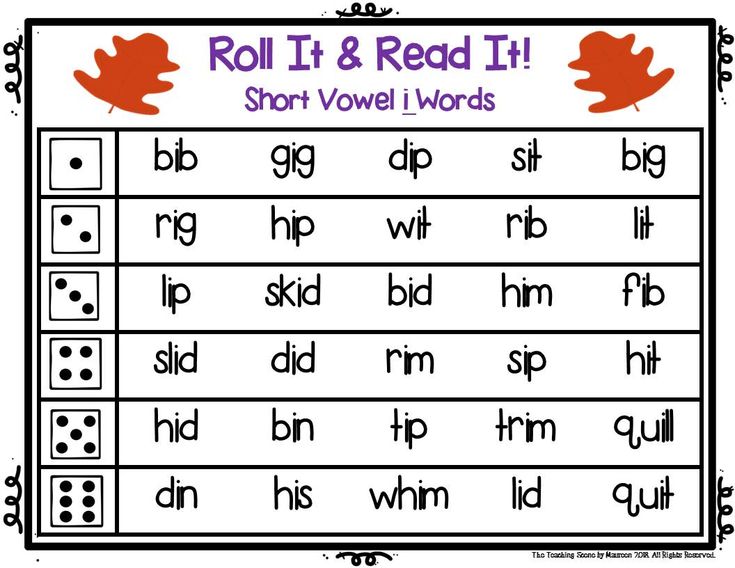 To summarize:
To summarize:
- Stressed vowels in open and closed syllables are long, and unstressed vowels are short.
- Vowels in closed syllables, regardless of stress, are short.
Long vowels in German: when?
In order not to bother with special cases, let's take the rules with the "maximum guarantee". German vowels are always pronounced long:
- When they are doubled: -aa-, -ee-, -oo- (-uu- and -ii- are rare, usually in compound words, double umlauts do not occur at all)
- Before “mute “H” (such an “H” is not pronounced, but only gives a long vowel)
- Before ß
- In letter combinations -ie-, -ieh-
- In monosyllabic, invariable words ending in “R”
- Stressed open syllable
- Stressed closed syllable
Good news! 4 rules out of 7 are easy to recognize in the text, and the rest after a little training will begin to be used intuitively.
Let's look at examples of how and when long German vowels are pronounced.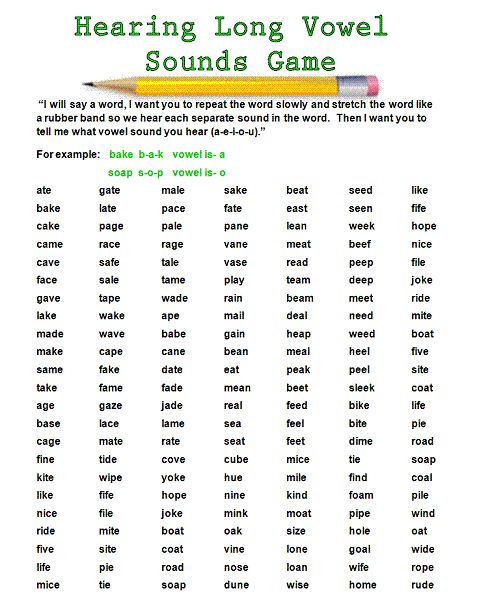 In the table below, for each word, two Russian transcriptions will be given: correct and incorrect. Having said both, you can in practice compare the sound of words and feel in what situations a long vowel occurs.
In the table below, for each word, two Russian transcriptions will be given: correct and incorrect. Having said both, you can in practice compare the sound of words and feel in what situations a long vowel occurs.
Short vowels in German: when?
Long vowels are clear, let's move on to short ones. There are only three basic rules at work here. German vowels are read briefly:
- In a closed syllable
- If they are followed by two or more consonants (that is, before letter combinations like -ch-, -sch-, -ck-, doubled and any other consonants that follow each other after another)
- Before the letter “X” - [x] (since “X” is read as [ks], formally this rule can be attributed to the previous one)
Consider short vowels with examples. As in the previous table, each word has one correct and one incorrect transcription.
Long and short vowels in monosyllabic words - a controversial case
In addition to monosyllabic words ending in "R" (with long vowels), there are many other short words in German in which only one consonant follows a vowel.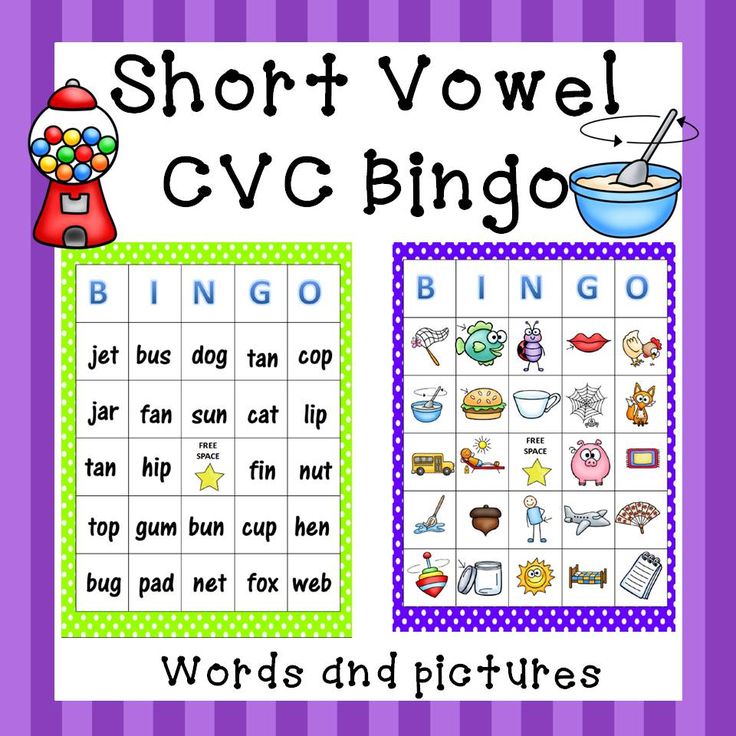 It can be articles, adjectives, nouns and other parts of speech. For example: dem, gut, Lid, Typ.
It can be articles, adjectives, nouns and other parts of speech. For example: dem, gut, Lid, Typ.
On the one hand, these are closed syllables, which means that the vowels in them are short. But it's not! There is no need to memorize anything here, you just need to understand that in such words both short and long vowel sounds can occur.
How to pronounce long and short vowels?
There is no secret here! Long vowels are pronounced longer than short vowels. That's why "you're not speaking correctly because my [a:] is longer than yours" doesn't work here.😎
The pronunciation of long and short vowels depends entirely on the speech apparatus, accent, dialect used, and other little things. Someone likes to "pull" sounds and even short letters sound like long ones. Someone pronounces short vowels so abruptly that long vowels sound like ordinary ones.
In general, as you like. The most important thing is that the difference between long and short sounds can be heard in speech.